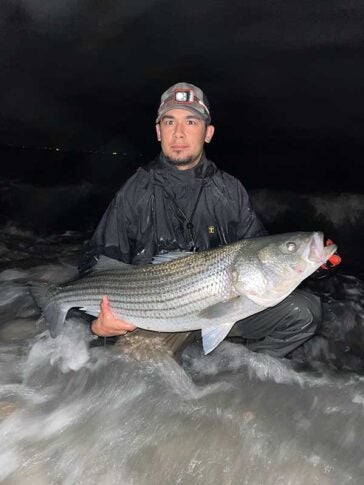 If you’ve been on social media recently you’ve likely heard the term “influencer” to describe popular content creators. Musicians, artists, comedians, even scientists: influencers get their title from an innate and creative ability to impact a wide audience.
If you’ve been on social media recently you’ve likely heard the term “influencer” to describe popular content creators. Musicians, artists, comedians, even scientists: influencers get their title from an innate and creative ability to impact a wide audience.
Izak Hill, MS, is currently a STEEP trainee and University of Rhode Island (URI) doctoral student under the supervision of STEEP Director Rainer Lohmann, PhD, and Anna Robuck, PhD, former STEEP trainee and
EPA Environmental Chemist. Hill was something of an up-and-coming influencer himself in the recreational fishing world. After amassing a bit of a following and even forming a relationship with some gear brands, Hill set out to become a different type of influencer.
No, this time he won’t be posting on Instagram about it or telling you about his favorite bait. But he will still be influencing scientists, policy makers, and the public while catching a few fish.
An “Estuary” for Research Interests
Hill’s love of all things fish goes back long before he joined STEEP as a Master’s trainee in 2019. His undergraduate research focused on fisheries management and limnology, where he worked under Southern Illinois University Carbondale professor’s Greg Whitledge, PhD, and Marjorie Brooks, PhD.
“My first project, which was also my senior capstone, involved using laser ablation-inductively coupled plasma-mass spectrometry (LA-ICP-MS) on walleye otoliths to confirm the applicability of this technology to differentiate between wild populations of walleye versus hatchery-raised walleye,” Hill explains. His work studying the inner ear bone (otolith) of freshwater fish may sound complicated, but the differences in the chemistry and structure of the otolith helps fisheries scientists distinguish where each specific walleye fish came from, be it farm or wild waters.
At first, this may seem a bit far from the environmental chemistry research within Rainer Lohmann’s STEEP lab, however, the otolith, part of the fish inner ear, can be used to study water chemistry within fish habitat. This complex approach to understanding fish environments was further bolstered by his extensive experience with small watercraft and field work. Thus, a natural connection to the research of STEEP was easily drawn.
“[Lohmann] offered me a project I simply could not pass up! While I thoroughly enjoyed my undergraduate fisheries research, it was the summers spent operating boats and diving into water chemistry that steered me in the direction of the crossroads between fisheries and environmental chemistry,” Hill says. “While they were separate projects, they blended well in the grand scheme that I enjoyed research in both scientific fields.”
Time For a New Challenge
Hill’s Master of Science was completed under the guidance of Lohmann and others on the STEEP team, which saw him investigating how fish accumulated different PFAS found in the waters of Cape Cod. However, upon the completion of this work, Hill found himself across the street from the URI Graduate School of Oceanography (GSO); this time as at the US EPA’s Atlantic Ecology Division as an ORISE Research Fellow, working under Robuck.
Hill’s decision to stick around RI was an easy one.
“Fishing has always been a large part of my life. My father learned from his father and the rest is history. For some, fishing is a leisurely pastime, an economic pursuit, a means for sustenance, or a sport, and I’ve had the pleasure of experiencing it for all of those reasons,” he explains. “I’ve fished the coasts of North Carolina, Georgia, and Florida, experienced freshwater fishing in the Midwest, and in the two decades I’ve spent fishing, I simply have not experienced a fishery quite like New England’s, specifically here in Rhode Island. So selfishly, this is one roundabout way of saying that fishing got me to stick around!”
New England’s Atlantic striped bass fishery is simply out of this world.
“During my MS degree, if I wasn’t in the lab, I was surfcasting for striped bass…I have lost countless hours of sleep devoting time to fishing for striped bass, which as a surfcaster, almost demands loss of sleep since the species is typically more active at night.”
And as many know, graduate does demand quite a bit of time and energy. However, even if Hill had to sacrifice a bit of time fishing for striped bass, the species’ life history piqued his interest scientifically as well. Striped bass may spend a lot of their adult time out the offshore coastal waters, but they return into estuaries, bays, and nearshore waters to mate. A transitory lifestyle means they’re exposed to more than one environmental contaminant.
“In the world of PFAS research, this presents unique opportunities to understand the implications of habitat use and PFAS bioaccumulation,” Hill explains, “when you have a species that spends most of its adult life undergoing significant biological and physiological changes due to spawning events and vast migrations from the Mid-Atlantic to as far north as Nova Scotia.”
This intersection between passion and science ultimately led Hill back to URI, where he is now a PhD student back under the guidance of Lohmann and Robuck. Those very same striped bass are part of a larger research project that will spawn (pardon the pun) no shortage of peer-reviewed articles.
Through his long-term research into PFAS in fish and natural waters, Hill hopes to contribute to decades-long battle against chemical impacts on local and global fisheries. It may not be glamorous, or create an endless stream of freebie fishing lures as Instagram might, but Hill’s found a way to be a fish influencer, after all.

